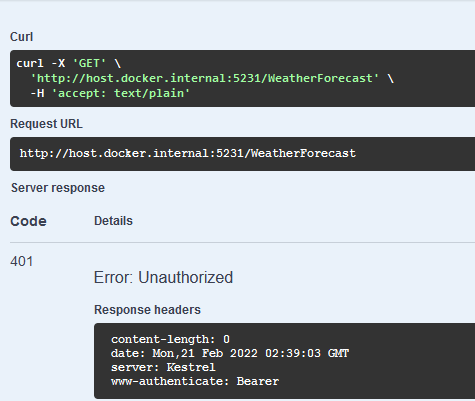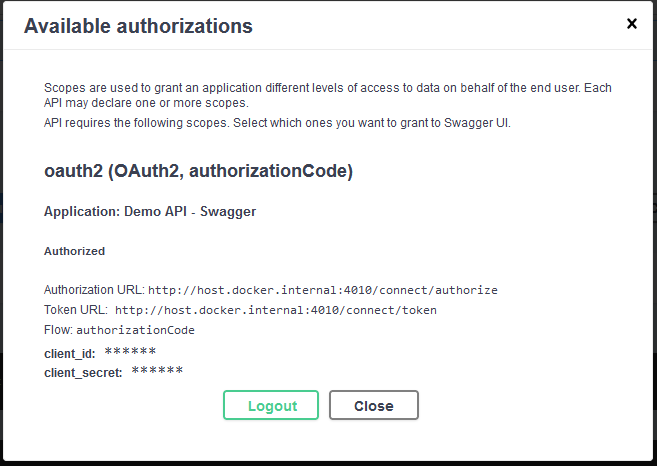Swagger不用多说,可以自动生成Web Api的接口文档和客户端调用代码,方便开发人员进行测试。通常我们只需要几行代码就可以实现这个功能:
...
builder.Services.AddSwaggerGen();
...
app.UseSwagger();
app.UseSwaggerUI();
...
可如果使用Identity Server 4等认证服务对Web Api进行保护后,使用上面代码生成的Web Api文档就无法工作了,在进行测试时会提示401错误。

本文介绍如何使Swagger在Identity Server 4认证服务保护下工作。
首先,使用开源的Identity Server 4 Admin搭建认证服务,这部分工作在系列文章《Identity Server 4 从入门到落地》中有详细的介绍,这里不再重复。
准备测试用Web Api接下来,使用Visual Studio 2022创建一个Asp.Net Core Web Api项目,我们使用项目中缺省的Web Api进行测试。在项目中增加Identity Server 4对Web Api的保护,这部分的详细介绍参见《Identity Server 4 从入门到落地(十)—— 编写可配置的客户端和Web Api》,这里只列出必要的步骤。
1、使用Nuget包管理器安装ZL.IdentityServer4ClientConfig和ZL.SameSiteCookiesService
2、修改Program.cs,增加如下代码:
...
builder.Services.AddIdentityServer4Api(builder.Configuration);//增加代码
builder.Services.AddSameSiteSupport();;//增加代码
...
app.UseCors("cors");//增加代码
app.UseAuthentication(); //增加代码
app.UseAuthorization();
3、在appSettings.json中增加相应的配置:
"IdentityServer4Api": {
"Authority": "http://host.docker.internal:4010",
"CorsOrgins": [
"http://host.docker.internal:5291"
],
"Policies": [
{
"Name": "ApiScope",
"RequireAuthenticatedUser": "true",
"Claims": [
{
"ClaimType": "scope",
"AllowValues": [ "testapi" ]
}
]
}
],
这里定义的认证服务器地址需要根据实际情况进行修改,CorsOrgins中设置的是允许访问的客户端的Uri。这里定义的允许访问的scope是testapi,需要根据实际进行修改。
4、为Web Api的Action增加[Authorize]标签:
[Authorize]
[HttpGet(Name = "GetWeatherForecast")]
public IEnumerable<WeatherForecast> Get()
{
return Enumerable.Range(1, 5).Select(index => new WeatherForecast
{
Date = DateTime.Now.AddDays(index),
TemperatureC = Random.Shared.Next(-20, 55),
Summary = Summaries[Random.Shared.Next(Summaries.Length)]
})
.ToArray();
}
现在我们在认证中心增加Web Api Scope和Swagger Client。
首先,增加Web Api Scope,在配置文件中定义的允许访问的scope是testapi,所以在这里增加的Scope名称必须为testapi。

然后,还需要为Swagger 增加一个客户端,名称为demo_api_swagger:

客户端定义中有几个地方需要注意,首先是允许作用域必须与前面定义的相同,这里是testapi:

需要客户端密钥设置为false:

还有重定向的Url,Swagger针对oauth 2.0的重定向地址是swagger/oauth2-redirect.html

最后,不要忘记在令牌分页中设置CORS:

在认证中心设置完成后,还需要修改Web Api项目中Swagger相关的代码,使Swagger支持认证。
首先需要增加一个类,实现IOperationFilter接口:
using Microsoft.AspNetCore.Authorization;
using Microsoft.OpenApi.Models;
using Swashbuckle.AspNetCore.SwaggerGen;
namespace WebApiIDS4Demo
{
public class AuthorizeCheckOperationFilter : IOperationFilter
{
public void Apply(OpenApiOperation operation, OperationFilterContext context)
{
var hasAuthorize =
context.MethodInfo.DeclaringType.GetCustomAttributes(true).OfType<AuthorizeAttribute>().Any()
|| context.MethodInfo.GetCustomAttributes(true).OfType<AuthorizeAttribute>().Any();
if (hasAuthorize)
{
operation.Responses.Add("401", new OpenApiResponse { Description = "Unauthorized" });
operation.Responses.Add("403", new OpenApiResponse { Description = "Forbidden" });
operation.Security = new List<OpenApiSecurityRequirement>
{
new OpenApiSecurityRequirement
{
[
new OpenApiSecurityScheme {Reference = new OpenApiReference
{
Type = ReferenceType.SecurityScheme,
Id = "oauth2"}
}
] = new[] {"api1"}
}
};
}
}
}
}
然后,在Program.cs中修改Swagger相关的代码:
...
builder.Services.AddSwaggerGen(options =>
{
options.SwaggerDoc("v1", new OpenApiInfo { Title = "Protected API", Version = "v1" });
var strurl = builder.Configuration["IdentityServer4Api:Authority"];
options.AddSecurityDefinition("oauth2", new OpenApiSecurityScheme
{
Type = SecuritySchemeType.OAuth2,
Flows = new OpenApiOAuthFlows
{
AuthorizationCode = new OpenApiOAuthFlow
{
AuthorizationUrl = new Uri( strurl +"/connect/authorize"),
TokenUrl = new Uri(strurl + "/connect/token"),
Scopes = new Dictionary<string, string>
{
{"testapi", "Demo API - full access"}
}
}
}
});
options.OperationFilter<AuthorizeCheckOperationFilter>();
});
...
if (app.Environment.IsDevelopment())
{
app.UseSwagger();
app.UseSwaggerUI(options =>
{
options.SwaggerEndpoint("/swagger/v1/swagger.json", "My API V1");
options.OAuthClientId("demo_api_swagger");
options.OAuthAppName("Demo API - Swagger");
options.OAuthUsePkce();
});
}
改造完成,可以进行测试了,运行Web Api项目,缺省进入Swagger文档页面,我们会发现多了一个Authorize按钮,并且Web Api方法旁边会有一个加锁的图标:

这时,如果访问Web Api,会出现401错误,我们需要先进行认证再访问,点击加锁的图标,弹出认证界面:

点击认证按钮,如果顺利的话,会出现认证完成的界面:

点击Close关闭窗口,会发现加锁图标发生了变化:

这时,再次访问Web Api就可以正常返回数据了:

